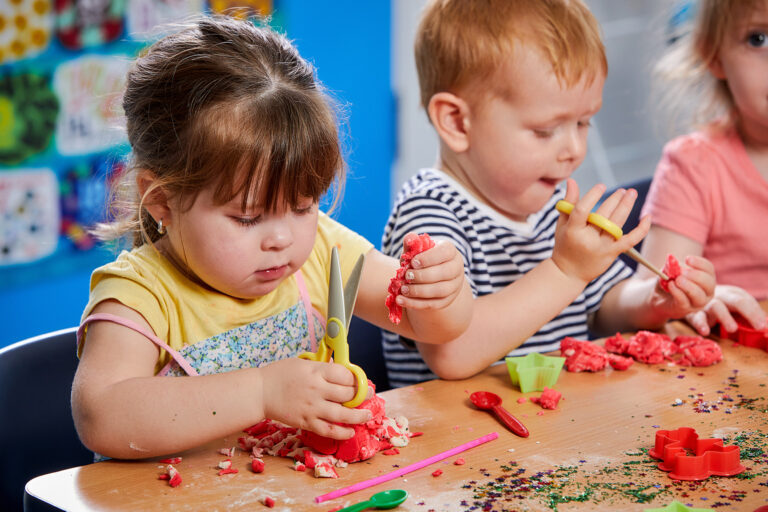
Post updated July 2025.
If you’ve ever handed your toddler a blob of playdough, you’ve likely seen the pure joy on their face. There’s something magical about the squish, stretch, and shape of it all, especially when they’re completely in control of what they create.
But playdough isn’t just fun. It’s an incredibly valuable learning tool that helps toddlers grow in so many ways - physically, emotionally, socially and cognitively. And the best part? It’s easy to use at home, no special toys or gadgets required.
At Aussie Kindies, we use sensory play every day to support children’s development. Here are eight ways playdough helps your toddler thrive, plus a simple recipe to make your own.
“We love watching the children roll and shape playdough into cupcakes, animals or imaginary friends. It’s amazing how their creativity grows alongside their fine motor skills. You can learn so much about how they see the world just by sitting down and playing alongside them.” - Educator, Aussie Kindies Early Learning
1. It Builds Fine Motor Strength
All that squishing, rolling, pinching, and patting strengthens the small muscles in your toddler’s hands and fingers. This kind of play supports important everyday skills like feeding themselves, brushing their teeth, or eventually holding a pencil.
Even your 1-year-old can get involved with basic squeezing and patting (just be sure to use taste-safe dough for little mouths that like to explore!).
2. It Sparks Creativity and Imagination
Playdough is open-ended and limitless. One day it’s a birthday cake, the next it’s a dinosaur or a worm family. Your toddler gets to decide what it becomes, which encourages problem-solving, creativity, and joyful experimentation.
3. It Offers Rich Sensory Experiences
From the soft, squishy texture to the colours and scents, playdough stimulates your child’s senses. This type of sensory play supports brain development and helps young children make sense of the world around them.
Want to know more about how sensory play helps? Read our blog post on the benefits of sensory play here.
4. It Boosts Language and Communication Skills
As children shape and pretend with their playdough, they often narrate what they’re doing, talking about the shapes, colours, or characters they’ve created. If they’re playing with you or a sibling, that back-and-forth conversation helps build vocabulary, storytelling skills, and confidence in expressing themselves.
5. It Helps Regulate Big Emotions
Playdough can be calming, almost like a stress ball for toddlers. The repetitive movement of kneading and shaping gives children a safe outlet for big feelings and helps them settle after an active play session or a busy morning.
6. It Introduces Early Math and Science Concepts
Your toddler may not know it, but they’re already learning STEM skills when they play with dough. They explore shapes, patterns, quantities, and cause-and-effect as they squish, cut, combine and rebuild.
Try counting little playdough balls together or comparing sizes (big, small, tiny) while you play.
7. It Fosters Social Skills
When toddlers play together with playdough, whether at home with siblings or in our learning environments, they practise sharing tools, taking turns, and working together on creative ideas. These everyday moments help build empathy, communication, and cooperation.
8. It Encourages Problem Solving
Trying to create a dog but ending up with a blob? That’s where the learning happens. As toddlers try to bring their ideas to life, they plan, adapt, and make decisions. These moments build cognitive flexibility and resilience in a low-pressure, playful way.
Easy Homemade Playdough Recipe
Making playdough at home is quick, budget-friendly, and fun to do with your child.
Ingredients:
- 2 cups plain flour
- ¾ cup salt
- 4 teaspoons cream of tartar
- 2 tablespoons vegetable oil
- 1 to 1.5 cups boiling water (adjust as needed)
- Food colouring (optional)
- Essential oils or extracts (optional - try lavender, peppermint, or vanilla)
Method:
- In a large mixing bowl, stir together flour, salt, and cream of tartar.
- Add vegetable oil.
- In a separate jug, mix food colouring and essential oils (if using) into the boiling water.
- Carefully pour the coloured water into the dry ingredients. Stir until a dough forms.
- Let cool slightly, then knead on a clean surface until smooth and elastic.
Tip: If the dough feels sticky, add a sprinkle of flour. If it’s too dry, knead in a few drops of water.
Playdough Variations and Ideas
- Gluten-free version: Use gluten-free flour
- Natural colours: Try beetroot juice (pink), turmeric (yellow), spinach or matcha (green), or cocoa (brown)
- Add texture: Mix in glitter, fine sand, or rice for extra sensory fun
- Storage: Keep in an airtight container in the fridge. If it dries out, knead in a few drops of water to revive
A Final Thought
Playdough might just look like squishy fun, but behind every roll and shape is a brain hard at work. For your toddler, this simple activity supports learning, connection, and confidence in ways that last a lifetime.
Want to see how we use play to support development at Aussie Kindies? Find your nearest centre and book a tour today.